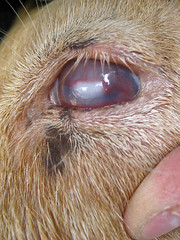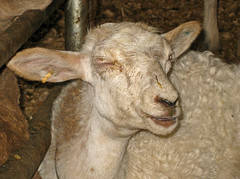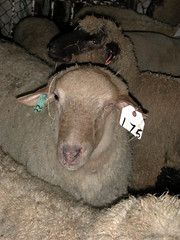 Pink eye is
an infectious and contagious bacterial disease of sheep, goats, and other
animals. Though most common in the summer and in young animals, it may occur
at any time of the year and in sheep and goats of any age. It occurs in
all sheep and goat-raising areas of the world, though the primary causative
organisms may vary.
Pink eye is
an infectious and contagious bacterial disease of sheep, goats, and other
animals. Though most common in the summer and in young animals, it may occur
at any time of the year and in sheep and goats of any age. It occurs in
all sheep and goat-raising areas of the world, though the primary causative
organisms may vary. Pink eye is caused by one of a number of different microorganisms. In the United States, the microorgansims most commonly associated with pinkeye in sheep and goats are Chlamydia psittaci ovis and Mycoplasma conjunctivae. The Chlamydia organism is the same organism that can cause enzootic abortions in ewes and does. Several other bacteria may play a secondary role in infections.
The causative organism(s) can be determined by a veterinary diagnostic lab from a scraping or swab of the conjunctiva. Depending upon the causative organism, pink eye can be contagious to people.
Symptoms
Pink eye tends to occur as an outbreak in a flock or herd. The causative organism is commonly introduced via purchased sheep or goats. The microorganisms that cause pink eye are widely distributed and may persist in resistant, carrier animals. Spread occurs via direct contact. Sheep and goats raised under intensive conditions are most commonly affected. When sheep and goats eat out of the
same trough, they can easily transmit or contract the disease. Overcrowding
and poor ventilation contribute to the spread of the disease. Dry, dusty
conditions and irritants such as flies tend to predispose or exacerbate
the disease. Flies or dust can carry the bacteria to the eye.
When sheep and goats eat out of the
same trough, they can easily transmit or contract the disease. Overcrowding
and poor ventilation contribute to the spread of the disease. Dry, dusty
conditions and irritants such as flies tend to predispose or exacerbate
the disease. Flies or dust can carry the bacteria to the eye. Whatever organism is responsible, the symptoms are similar. Affected animals blink repeatedly and have an aversion to bright sunlight. The side of the face below the eye may be wet due to tearing. Upon close examination, the membranes of the eye appear red and inflamed. The eyes become cloudy or opaque. An ulcer may develop. The condition is painful and may affect one or both eyes. Pink eye can cause temporary blindness in affected animals; permanent blindness in severe cases.
Sheep and goats rarely die from pink eye. The cost of the disease is associated with treatment costs (medicine and labor) and production losses, as affected animals may have difficulty finding food and water. Animals that suffer temporary blindness may require hand feeding or watering to prevent production losses.
Treatment
Affected animals should be isolated from the rest of the flock to prevent spread of the disease. They should be housed in a clean, dry, comfortable, and shady place.Pink eye is usually treated with any number of antibiotics that are injected into the body or placed directly in the eye. The most common treatment is to apply terramycin ointment to the affected eye(s) two to four times per day. Some veterinarians advocate the use of intramammary mastitis tubes for the treatment of pink eye. As with the terramycin ointment, the antibiotic is applied directly to the eye.
 Ointments
are usually more effective than powders or sprays. They are less irritating
to the already inflamed eye. Eye drops are easier to administer than ointments.
Before applying medicine to the eye, the animal's face should be cleaned
and the debris around the eye(s) should be removed. Surgical gloves should
be used when affected animals are handled.
Ointments
are usually more effective than powders or sprays. They are less irritating
to the already inflamed eye. Eye drops are easier to administer than ointments.
Before applying medicine to the eye, the animal's face should be cleaned
and the debris around the eye(s) should be removed. Surgical gloves should
be used when affected animals are handled. Sometimes, subconjunctival injections of penicillin are given or the antibiotic is dropped into the eye. When it is not practical to treat individual animals repeatedly, antibiotics may be injected systemically. Long-acting oxytetracyclines (e.g. LA-200®) are most commonly used. The additition of oxytetracycline to be the feed may be beneficial. Tylosin (Tylan®) is also effective against the causative organisms of pink eye.
Because most of these antibiotic treatments are not FDA-approved to treat pink eye in sheep and/or goats, veterinary advice should be sought. Extra-label drug use requires veterinary approval, even if the drugs can be purchased over-the-counter or via mail order. Subconjunctival injections should not be attempted by lay people.
Despite intensive efforts, treatment may have little effect on the course or severity of the disease. Pink eye is similar to sore mouth (orf) in that the disease is usually self-limiting and the majority of affected animals will clear up without treatment, usually in a week to 10 days. Severely affected animals may take longer to recover. Recovered animals have resistance for varying lengths of time. It is possible for them to become reinfected, as acquired immunity is not strong or long-lasting.
Prevention
 There is no
vaccine to prevent pink eye in sheep and goats. Because the microorganisms
that cause pink eye in cattle (Moraxella bovis) are different from
the ones that cause pink eye in sheep and goats, the vaccine used to prevent
pink eye in cattle will not prevent pink eye in sheep or goats.
There is no
vaccine to prevent pink eye in sheep and goats. Because the microorganisms
that cause pink eye in cattle (Moraxella bovis) are different from
the ones that cause pink eye in sheep and goats, the vaccine used to prevent
pink eye in cattle will not prevent pink eye in sheep or goats.The best way to prevent pink eye is to maintain a closed flock or herd. Do not purchase animals from public auctions. Isolate new livestock for at least 30 days. Show animals should also be isolated upon returning to the farm, as pink eye is common at fairs and expositions.
Dust and fly control will aid in the control and spread of pink eye. Protection from sunlight should be provided. Complete disease eradication is difficult because the organisms that cause pinkeye are widespread and may persist in carrier animals.
No comments:
Post a Comment